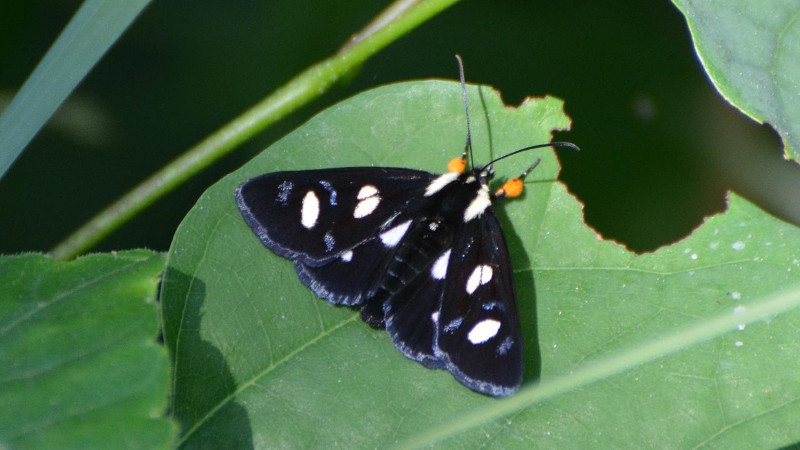Eight Spotted Forester Moth Facts
- This magnificent Lepidoptera is most commonly referred to by the somewhat cumbersome term of the Eight Spotted Forester Moth. For the moment, unlike many of its related species, this marvel has no other generally accepted common name.
- Professional researchers, meanwhile, typically refer to the insect by its official scientific name. That term, however, doesn’t really roll off the tongue much more easily. That’s because it’s scientific name is the equally hard to pronounce Alypia octomaculata.
- The Arthropod received that name at the hands of the renowned Danish researcher Johan Christian Fabricius. The respected zoologist made the first formal recognition of it as a separate and distinct species. That noteworthy even occurred in 1775.
- This beautiful insect holds a better position than many. For the moment, this marvel of Nature appears to be maintaing a population base that’s both sizeable and stable. This further appears to hold true throughout the entirety of its natural range.
- The IUCN, therefore, currently has no listing for the Eight Spotted Forester Moth. Any such status would be reflected on the organization’s Red List of Threatened Species. That fortunate situation, however, could potentially change in the very near future.
- That’s due to the fact that, like most species, if not all, it faces potential threats to its existence. One of those consists of habitat loss, due to human expansion and activities. Its greatest potential threat, though, likely comes from ongoing climate change.
Related Articles
Eight Spotted Forester Moth Physical Description
The fabulous Eight Spotted Forester Moth actually often passes for a butterfly, among the non-professionals who encounter them. Indeed, the amazing invertebrate strongly resembles its cousins in terms of both behavior and general physical appearance.
Although it’s a truly impressive species, it doesn’t earn that accolade based on sheer physical size. That’s because it’s an average-sized member of its genus. It also displays no discernible amount of the physiological characteristic known as sexual dimorphism.
Individuals of both genders therefore appear virtually identical to the naked eye. In terms of size, mature specimens attain an average wingspan of roughly 1 – 1.5 in (2.5 – 3.8 cm). Exceptional individuals do occur, of course, but these remain extremely uncommon.
The overall coloring of adult examples of the Eight Spotted Forester Moth remains principally black. Various parts of the wings do, however, display small variations in this pattern. The body, meanwhile, generally remains almost entirely black in coloring.
The wings of the Arthropod, though, do show some spots of color. Each forewing manifest two light yellow spots. The hindwings also each display two spots, these being white in color. Patches of bright orange hairs also develop on both the front and middle pair of legs.
- Kingdom: Animalia
- Phylum: Arthropoda
- Class: Insecta
- Order: Lepidoptera
- Family: Noctuidae
- Genus: Alypia
- Species: A. octomaculata
Eight Spotted Forester Moth Distribution, Habitat, and Ecology
Regrettably, the stunning Eight Spotted Forester Moth inhabits a moderately restricted swathe of the globe. That range also has a highly broken nature to it. For the moment, no evidence exists to indicate that it ever possessed a more extensive range.
This inspiring creation of Nature and evolution evolved as native to a limited portion of North America. Its population mainly appears in the eastern portion of the United States. Smaller groupings, though, also appear in parts of the countries of Canada and Mexico.
Even within its native range, this Lepidoptera has very specific requirements for its choice of habitat. The vast majority of adults appear in the narrow zone where wooded areas meet open areas. This unique placement serves to meet two of its principal needs.
That’s due to the dietary needs of both its adult and larval forms. The open areas provide the adults with quantities of flowers, from which they feed on the nectar they require. The larva, meanwhile, find the specific plants upon which they feed in the wooded areas.
Adults of the Eight Spotted Forester Moth most commonly appear in the Spring. In warmer regions, two lifecylces occur per year. The dense, forested regions also provide the adults with sufficient foliage for the laying of their eggs, typically under the leaves.
This natural wonder truly stands out from most of its relatives due to its behavioral patterns. That’s due to the fact that, unlike most moths, it flies during the daytime. Its feeding activities further serve as a source of pollination for the many various flowers in its area.
Species Sharing Its Range
Check out our other articles on 6 Laudably Luscious Lilies, Horn Shark, Saint Mary’s Islands, Southern Tamandua, Chinese Giant Salamander, Philippine Crocodile, Tufted Coquette

